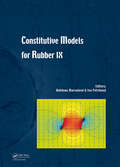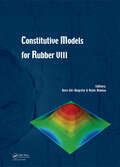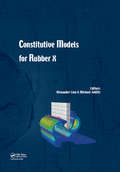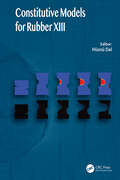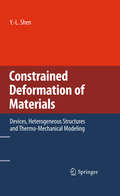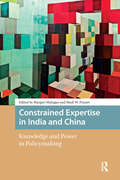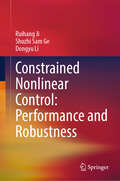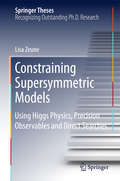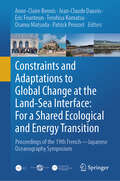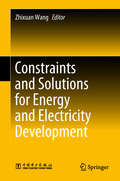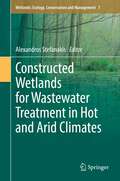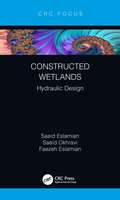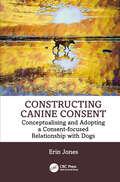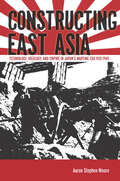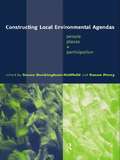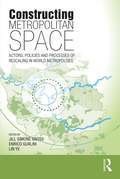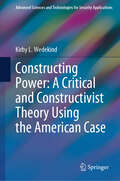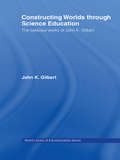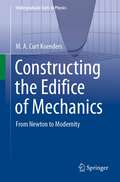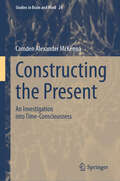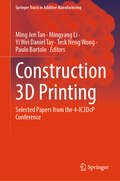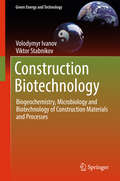- Table View
- List View
Constitutive Models for Rubber IX
by Bohdana Marvalová Iva PetríkováThe unique properties of rubber make it ideal for use in a wide variety of engineering applications such as tyres, engine mounts, shock absorbers, flexible joints and seals. Developing diverse elastomeric elements for various structures involves numerical simulations of their performance, which are based on reliable constitutive models of the mater
Constitutive Models for Rubber VIII
by Nere Gil-Negrete Asier AlonsoDue to their unique properties, rubber materials are found in multiple engineering applications such as tires, engine mounts, shock absorbers, flexible joints, seals, etc. Nevertheless, the complex nature of the behavior of such material makes it difficult to accurately model and predict the performance of these units.The challenge to correctly rep
Constitutive Models for Rubber X: Proceedings of the European Conference on Constitutive Models for Rubbers X (Munich, Germany, 28-31 August 2017)
by Alexander Lion Michael JohlitzIn order to develop innovative products, to reduce development costs and the number of prototypes and to accelerate development processes, numerical simulations become more and more attractive. As such, numerical simulations are instrumental in understanding complicated material properties like chemical ageing, crack propagation or the strain- and temperature-induced crystallisation of rubber. Therefore, experimentally validated and physically meaningful constitutive models are indispensable. Elastomers are used for products like tyres, engine and suspension mounts or seals, to name a few. The interest in modelling the quasi-static stress-strain behaviour was dominant in the past decades, but nowadays the interests also include influences of environmental conditions. The latest developments on the material behaviour of elastomers are collected in the present volume. Constitutive Models for Rubber X is a comprehensive compilation of nearly all oral and poster contributions to the European Conference on Constitutive Models for Rubber (Munich, 28-31 August 2017). The 95 highly topical contributions reflect the state of-the-art in material modelling and testing of elastomers. They cover the fields of material testing and processing, filler reinforcement, electromagnetic sensitive elastomers, dynamic properties, constitutive modelling, micromechanics, finite element implementation, stress softening, chemical ageing, fatigue and durability. In the area of rubbery materials and structures, applied research will play an important role also in the coming decades. Constitutive Models for Rubber X is of interest to developers and researchers involved in the rubber processing and CAE software industries, as well as for academics in nearly all disciplines of engineering and material sciences.
Constitutive Models for Rubbers XIII
by Hüsnü DalConstitutive Models for Rubber XIII is a comprehensive compilation of the oral and poster contributions to the XIII European Conference on Constitutive Models for Rubbers (İstanbul, Türkiye, 26-28 June 2024). The XIII edition again brought together researchers from the industry and the academia working in the field of elastomer technology and science to discuss the most recent advancement in the following topics:• Constitutive models• Micro-structural investigations• Experimental methods and characterization• Numerical methods• Fatigue and fracture• Aging• Industrial applications• Smart elastomer materials: applications and modelling• Recyclable elastomer systems design and modellingIncluding 53 contributions from authors from around the world, this book aims at professionals and academics interested in recent advances in elastomer technology and science.
Constrained Deformation of Materials: Devices, Heterogeneous Structures and Thermo-Mechanical Modeling
by Y. L. Shen"Constrained Deformation of Materials: Devices, Heterogeneous Structures and Thermo-Mechanical Modeling" is an in-depth look at the mechanical analyses and modeling of advanced small-scale structures and heterogeneous material systems. Mechanical deformations in thin films and miniaturized materials, commonly found in microelectronic devices and packages, MEMS, nanostructures and composite and multi-phase materials, are heavily influenced by the external or internal physical confinement. A continuum mechanics-based approach is used, together with discussions on micro-mechanisms, to treat the subject in a systematic manner under the unified theme. Readers will find valuable information on the proper application of thermo-mechanics in numerical modeling as well as in the interpretation and prediction of physical material behavior, along with many case studies. Additionally, particular attention is paid to practical engineering relevance. Thus real-life reliability issues are discussed in detail to serve the needs of researchers and engineers alike.
Constrained Expertise in India and China: Knowledge and Power in Policymaking (Politics and International Relations in Asia)
by Mark W. Frazier Mahajan ManjariConstrained Expertise in India and China explores what kinds of knowledge and knowledge purveyors get mobilized and privileged, and what gets sidelined in policymaking in India and China. Through its detailed empirical studies in both countries, the volume illuminates a trend of increasing concentration of political authority which has frequently demanded that experts be aligned with the central government’s agenda. Spaces are shrinking for divergent and oppositional viewpoints, whether these come from the bureaucracy, academia, think tanks, or NGOs. The declining autonomy of experts has been exacerbated by institutional structures, since knowledge purveyors that directly contribute to policymaking typically have been embedded within bureaucracies or otherwise dependent on the state rather than occupying independent bases. Both countries face the challenge of how to build and sustain ecosystems of heterogeneous experts that are not simply echo chambers of executive authority. The edited collection represents a pathbreaking contribution to the study of expertise and governance in India and China.
Constrained Nonlinear Control: Performance and Robustness
by Shuzhi Sam Ge Dongyu Li Ruihang JiThis book is concerned with nonlinear control with performance-related and system-ability-related constraints. It presents novel work on several kinds of commonly encountered nonlinear systems, including those with stricter transient performance requirements, those with two types of constraints, those with no initial-condition limitation, and those with limited resources. It shows how nonlinear systems with severe constraints can be successfully controlled with our powerful control design. Typically, the book discusses a Tunnel Prescribed Control for achieving enhanced performance; provides a comprehensive solution, namely, Saturation-tolerant Prescribed Control, to handle the conflict between constraints; and then develops a Self-adjustable Prescribed Control to address the defined Entry Capture Problem that performance constraints are satisfied after (rather than from the beginning of) system operation. As such, the book will be of interest to researchers and graduate students in the fields of nonlinear systems, constrained control, and control engineering who would like to find out about the performance, robustness, and applications of constrained nonlinear systems.
Constraining Supersymmetric Models: Using Higgs Physics, Precision Observables and Direct Searches (Springer Theses)
by Lisa ZeuneThis thesis analyses how supersymmetric (SUSY) extensions of the Standard Model (SM) of particle physics can be constrained using information from Higgs physics, electroweak precision observables and direct searches for new particles. Direct searches for SUSY particles at the LHC have not resulted in any signal so far, and limits on the SUSY parameter space have been set. Measurements of the properties of the observed Higgs boson at 125 GeV as well as of the W boson mass can provide valuable indirect constraints, supplementing the ones from direct searches. Precise calculations are performed for Higgs decays and electroweak precision observables within the minimal supersymmetric extension of the Standard Model and the next to-minimal supersymmetric extension of the Standard Model. Furthermore, a method is presented to reinterpret the LHC limits from direct SUSY searches in more realistic SUSY scenarios. The phenomenological consequences of those results are thoroughly analysed.
Constraints and Adaptations to Global Change at the Land-Sea Interface: Proceedings of the 19th French—Japanese Oceanography Symposium
by Patrick Prouzet Teruhisa Komatsu Eric Feunteun Anne-Claire Bennis Jean-Claude Dauvin Osamu MatsudaCoastal or semi-enclosed seas, coastal or interface zones between land and sea are areas widely coveted by numerous human activities. These activities do not assess the effects and impacts of their cumulative pressures on the natural environment: coastal development, tourism, terrestrial pollution, maritime transport, dredging and piling, extraction of marine aggregates and development or planned development of marine wind farms or tidal turbines. In this context and despite the high productivity of these ecosystems, fishing and shellfish farming, which also exert their own environmental pressures, have some difficulties in ensuring their sustainability in an increasingly man-made environment and generating increasingly exacerbated conflicts of use. The symposium will address some aspects of resilience (via their capacity to adapt to global change) of these coastal ecosystems and adaptation of human communities to climate change in a context of full use of natural resources. A more holistic approach to the impact of all uses on the environment to ensure a more optimal management of the Commons, needs to be implemented. In Japan, the concept of Sato-umi (harmony between the coastal sea and local communities) is being implemented and incorporates participatory science and active restoration projects in an integrated coastal zone management framework.
Constraints and Solutions for Energy and Electricity Development
by Zhixuan WangThis book primarily focuses on constraints and solutions for energy and electric power development. On the basis of analyses, proposes a planning index system including 26 binding indicators and the breaking constraints measures. Offering significant insights and proposals concerning the current status of energy development and the key limiting factors to sustainable energy development in China, it is a valuable resource for policy-makers, managers and researchers in the energy sector.
Constructal Law and the Unifying Principle of Design (Understanding Complex Systems)
by Adrian Bejan Sylvie Lorente Luiz A.O. RochaDesign happens everywhere, whether in animate objects (e.g., dendritic lung structures, bacterial colonies, and corals), inanimate patterns (river basins, beach slope, and dendritic crystals), social dynamics (pedestrian traffic flows), or engineered systems (heat dissipation in electronic circuitry). This "design in nature" often takes on remarkably similar patterns, which can be explained under one unifying Constructal Law. This book explores the unifying power of the Constructal Law and its applications in all domains of design generation and evolution, ranging from biology and geophysics to globalization, energy, sustainability, and security. The Constructal Law accounts for the universal tendency of flow systems to morph into evolving configurations that provide greater and easier access over time. The Constructal Law resolves the many and contradictory ad hoc statements of "optimality", end design, and destiny in nature, such as minimum and maximum entropy production and minimum and maximum flow resistance, and also explains the designs that are observed and copied in biomimetics. Constructal Law and the Unifying Principle of Design covers the fundamentals of Constructal Theory and Design, as well as presenting a variety of state-of-the-art applications. Experts from the biological, physical and social sciences demonstrate the unification of all design phenomena in nature, and apply this knowledge to novel designs in modern engineering, such as vascularization for self-healing and self-cooling materials for aircraft, and tree fins and cavities for heat transfer enhancement.
Constructed Wetlands for Wastewater Treatment in Hot and Arid Climates (Wetlands: Ecology, Conservation and Management #7)
by Alexandros StefanakisThis edited book presents the first collection of case studies and research projects on the sustainable technology of constructed wetlands for wastewater management under hot and arid climates. It is the first such work that summarizes in a single reference the current international experiences and knowledge on the implementation of this nature-based solution under these diverse and often harsh climatic conditions. It covers the relevant gap in the fragmented and limited literature by providing integrated information and documentation on the feasibility of this green technology.The book presents the treatment efficiency of constructed wetland facilities and the research output from 29 different countries across South America, Africa, Asia and Oceania, while it covers various applications such as domestic and municipal wastewater, various industrial effluents and municipal sludge. Many examples and case studies further demonstrate the potential of this technology to contribute to better address the issues of water scarcity and limited fresh water resources through circular management of treated effluents e.g. reuse in irrigation. It also discusses the various challenges and technical aspects that should be considered in such climates, along with the environmental, financial and social benefits of this technology.This work is a useful handbook and guide for professional engineers, practitioners, academics, researchers, students, and water authorities who wish to get a better understanding and first-hand information on the potential of constructed wetlands for cost-effective and sustainable wastewater management in countries with hot and arid climates.
Constructed Wetlands: Hydraulic Design
by Saeid Eslamian Saeid Okhravi Faezeh EslamianConstructed Wetlands: Hydraulic Design provides fundamental information on internal wetland hydraulic and biochemical processes, as well as practical guidance on the effective design of wetlands for water treatment. It includes the latest innovations and technological advances of constructed wetlands based on the newest technologies in the field. <p><p>Features: <li>Explains how various pollutants are either retained or removed from treatment systems <li>Examines system geometry, flow rate, inlet-outlet configurations, and more <li>Offers useful guidance and tools to practitioners for designing wastewater treatment structures naturally and optimally <li>Introduces the various aspects of hydraulic engineering through porous media <p><p>This book will serve as a valuable resource for practicing professionals, researchers, policy makers, and students seeking to gain an in-depth understanding of the hydraulic processes involved in constructed wetlands water treatment systems.
Constructing Canine Consent: Conceptualising and adopting a consent-focused relationship with dogs
by Erin JonesThe concept of canine consent is far more than simply a buzzword in modern dog training practices. In its current form, consent is a distinctly human concept, designed by humans and for humans. Looking beyond species boundaries can help us not only consider concepts of canine consent and autonomy, but it can also help us to apply these concepts in our everyday interactions with dogs, which is fundamental for any professional working with dogs as well as for everyday dog caregivers. This canine-indexed definition of consent includes a model of five major categories: Touch/interaction-based consent, cooperative care using learned consent behaviours, activity consent, consent-based learning, and substitutive consent. These categories involve a two-way communication system, integration of salient choices, teaching consent behaviours and incorporating existing training protocols that adhere to the Humane Hierarchy of best practices, and an evaluation of dependent decision-making in extenuating circumstances. This book aims to merge the existing literature and new understandings about canine consent to paint a complete picture. It will challenge the current expectations of dogs and dog behaviour in our society with an intention of considering their perspectives, experiences, and emotional needs. It will be important reading for veterinary professionals, dog trainers and behaviourists, those involved in work with therapy dogs, and anybody working with or caring for dogs.
Constructing East Asia: Technology, Ideology, and Empire in Japan's Wartime Era, 1931-1945
by Aaron Stephen MooreThe conventional understanding of Japanese wartime ideology has for years been summed up by just a few words: anti-modern, spiritualist, and irrational. Yet such a cut and dried picture is not at all reflective of the principles that guided national policy from 1931–1945. Challenging the status quo, Constructing East Asia examines how Japanese intellectuals, bureaucrats, and engineers used technology as a system of power and mobilization—what historian Aaron Moore terms a "technological imaginary"—to rally people in Japan and its expanding empire. By analyzing how these different actors defined technology in public discourse, national policies, and large-scale infrastructure projects, Moore reveals wartime elites as far more calculated in thought and action than previous scholarship allows. Moreover, Moore positions the wartime origins of technology deployment as an essential part of the country's national policy and identity, upending another predominant narrative—namely, that technology did not play a modernizing role in Japan until the "economic miracle" of the postwar years.
Constructing Local Environmental Agendas: People, Places and Participation
by Susan Percy Susan Buckingham-HatfieldConstructing Local Environmental Agendas draws on original contributions from specialists worldwide to argue that there is scope for local areas to improve their environments, provided local people are involved. International case studies, from UK, Europe, Australia, Pakistan and Sri Lanka, demonstrate the importance of respect for indigenous knowledge and the need to remove layers of bureaucracy from policy making.
Constructing Metropolitan Space: Actors, Policies and Processes of Rescaling in World Metropolises
by Lin Ye Jill Simone Gross Enrico GualiniThere is little question today that processes of globalization affect national and local economies, governance processes, and conditions for economic competitiveness in the major urban regions of the world. In most liberal-democratic countries, these processes are occurring according to a rationale which attempts to combine strategies of state-supported development with increasing local-regional governmental decentralization and autonomy. Against this background, the issue of metropolitan development is being redefined worldwide, along with its institutional frameworks, modes of governance, policy instruments, and spatial planning strategies. The overarching assumption of this volume is that ‘metropolitan space’, far from being consolidated as a policy object, is currently being redefined and in some instances ‘constructed’ and contested as a scale, through a variety of policy practices related to spatial-economic development objectives. Through case studies drawn from across four continents, the authors reveal a range of interesting cross-national commonalities concerning the power that state actors, situated at various spatial scales, exert as agents in these processes. This volume interrogates key research issues raised by these developments, and is intended as a contribution to the establishment of a globally comparative analysis of the construction of metropolitan spaces and scales under conditions of globalization and neoliberalization.
Constructing Power: A Critical and Constructivist Theory Using the American Case (Advanced Sciences and Technologies for Security Applications)
by Kirby L. WedekindThis book asserts that there exists a causal relationship between identity, interest, and the exercise of power. The work defines power as the ability to satisfy oneself, which makes power contingent upon belief. It also dissects the concepts of identity, interest, and power to reveal how each works and relate to the others. This analysis creates a new theory of power using constructivism informed by critical theory, departing from neorealist and neoliberal perspectives. The work uses the United States to test the theory by examining US national identity, interest, and exercises of power. A deconstruction of American Exceptionalism proceeds three case studies and runs as a theme to connect each, unifying the work. A military operation in 2016 against the Islamic State in Libya, the 2014 Russian annexation of Crimea, and the whiplash caused by US participation in the 2015 Paris Agreement serve as the three case studies for analyzing US identity, interest, and power through the theory. This work proposes a new way of understanding power based on constructivism and informed by critical theory that applies to interpersonal and international relationships. Every relation is a power relation and power is the ability to satisfy oneself. This book provides insight into the underlying causes and machinations that transpire within every kind of social relation. This is a significant shift in how power is understood and applied in politics, the military, business, and interpersonal relationships. This book seeks to provide the reader with greater and clearer understanding of themselves, the world in which they live, and why it exists as such.
Constructing Reality
by John Marburger IIIQuestions of the fundamental nature of matter continue to inspire and engage our imagination. However, the exciting new concepts of strings, supersymmetry and exotic matter build on ideas that are well known to physicists but mysterious and puzzling to people outside of these research fields. Covering key conceptual developments from the last century, this book provides a background to the bold ideas and challenges faced by physicists today. Quantum theory and the Standard Model of particles are explained with minimal mathematics, and advanced topics, such as gauge theory and quantum field theory, are put into context. With concise, lucid explanations, this book is an essential guide to the world of particle physics.
Constructing Reality: Quantum Theory and Particle Physics
by John Marburger IIIQuestions of the fundamental nature of matter continue to inspire and engage our imagination. However, the exciting new concepts of strings, supersymmetry and exotic matter build on ideas that are well known to physicists but mysterious and puzzling to people outside of these research fields. Covering key conceptual developments from the last century, this book provides a background to the bold ideas and challenges faced by physicists today. Quantum theory and the Standard Model of particles are explained with minimal mathematics, and advanced topics, such as gauge theory and quantum field theory, are put into context. With concise, lucid explanations, this book is an essential guide to the world of particle physics.
Constructing Worlds through Science Education: The Selected Works of John K. Gilbert
by John K. GilbertInternationally renowned and award-winning author John Gilbert has spent the last thirty years researching, thinking and writing about some of the central and enduring issues in science education. He has contributed over twenty books and 400 articles to the field and is Editor-in-Chief of the International Journal of Science Education. For the first time he brings together sixteen of his key writings in one volume. This unique book highlights important shifts in emphasis in science education research, the influence of important individuals and matters of national and international concern. All this is interwoven in the following four themes: explanation, models and modeling in science education relating science education and technology education informal education in science and technology alternative conceptions and science education.
Constructing the Edifice of Mechanics: From Newton to Modernity (Undergraduate Texts in Physics)
by M.A. Curt KoendersThis book deals with theoretical mechanics. Newton published the "Philosophiæ Naturalis Principia Mathematica" in 1687. In it, he sets out the basic principles of physics that are required to understand the motion of the planets, their moons, and the comets in the solar system. It includes the gravitational (inverse square) law, the inertial principle, and the basic elements of mechanics. Since its publication, a large number of refinements and reformulations have been introduced, thereby adding enormous insight into the structure of mechanics, which is commonly known as “classical mechanics”. All these have in common that by taking a suitable limit, Newton's original principles re-appear. Thus, physicists and mathematicians who work on the subject always have a notion that if their theories do not return to Newton's foundations, then there is something wrong. Newton himself acknowledged that 'if I have seen further (than others), it is by standing on the shoulders of giants'. One of these giants was undoubtedly Galileo who died in the year Newton was born. So, Newton himself adhered to the 'classical limit'.
Constructing the Present: An Investigation into Time-Consciousness (Studies in Brain and Mind #24)
by Camden Alexander McKennaConstructing the Present: An Investigation into Time-Consciousness investigates what time is like for us as subjects and answers the question of how our experiential present comes to be. While addressing a variety of outstanding debates in the field, the book proposes that our temporal phenomenology is best understood as transcending traditional forms of analysis. The book ultimately concludes that time is not something we experience, but rather the way we construct our experience of the world. In the spirit of William James, McKenna suggests that the present occupies a window of time known as the &“specious present.&” McKenna claims that the duration of this subjective window is determined by the real temporal properties of experience, but also that experiential events are, as Edmund Husserl believed, temporally directed to varying degrees and in nested fashion in a way that affects their particular qualitative character. This specific proposal is called ERA: the Extensional-Retentional Analysis of temporal phenomenology. Besides doing justice to our temporal phenomenology, McKenna&’s overall position aligns with contemporary predictive approaches to the cognitive architecture of the mind. This exciting new way of thinking sees the brain as a predictive engine whose ongoing activities construct our rich subjective experiences. Taking inspiration from this movement, Constructing the Present introduces a complementary position called Temporality as Iterative Expectation Revision (or TIER). According to TIER, temporal phenomenology results from predictive activities of the brain occurring throughout an integrated multilevel cognitive processing hierarchy. Such a system is sensitive to the ongoing flux of environmental stimuli while retaining prior expectations and constantly updating our experiences probabilistically to ensure survival. The actual activity of this ongoing process, rather than its content, gives rise to the felt present, which is continuously constructed anew. Constructing the Present: An Investigation into Time-Consciousness functions as a scholarly defense of a provocative, plausible, and cohesive set of theses, while also confronting numerous adjacent philosophical issues along the way. By approaching the subject from the standpoint of empirically informed philosophy of mind, the present work fills a significant gap in the literature. The book should appeal especially to philosophically inclined researchers and students interested in cognitive science, psychology, and neuroscience, as well as philosophy of mind.
Construction 3D Printing: Selected Papers from the 4-IC3DcP Conference (Springer Tracts in Additive Manufacturing)
by Ming Jen Tan Mingyang Li Yi Wei Daniel Tay Teck Neng Wong Paulo BartoloThis book presents the dynamic advancements achieved in Construction 3D Printing, showcasing a wealth of insights from the conference held from 19-21 July 2023 at Nanyang Technological University (NTU), Singapore. Covering a broad spectrum of topics, this volume presents research on established technologies, modeling, simulation, diverse materials (including recycled and geopolymer materials), fiber reinforcement, and composite materials, as well as testing protocols and standards. It also delves into applications, Building Information Modeling (BIM), design methodologies, optimization strategies, structural considerations, intelligent monitoring, and the role of robotics and automation. Serving as a timely and invaluable resource, this book offers both scholars and professionals in the expansive field of Construction 3D Printing profound insights into its decade-long progress and its preparedness for wider adoption.
Construction Biotechnology: Biogeochemistry, Microbiology and Biotechnology of Construction Materials and Processes (Green Energy and Technology)
by Volodymyr Ivanov Viktor StabnikovThis book presents the first comprehensive text on construction biomaterials and bioprocesses. It details aspects of construction biotechnology, a new interdisciplinary area involving applications of environmental and industrial microbiology and biotechnology in geotechnical and civil engineering. It also critically reviews all existing and potential construction biotechnology processes. It discusses a number of topics including the biotechnological production of new construction materials such as self-healing concrete, construction biocomposites, construction bioplastics, and biotechnological admixtures to cement. It also addresses construction-related processes like biocementation, bioclogging, soil surface fixation and biosealing, microbial cements and grouts, the biocoating of construction material surfaces, the microbiology and biosafety of the construction environment, the prevention of biocorrosion as well as biodeterioration and biofouling in civil engineering. Biomediated precipitation of calcium, magnesium, and iron compounds as carbonates, phosphates, sulphides, and silicate minerals in soil for its clogging and strengthening are considered from geotechnical, chemical, and microbiological points of view. It offers an overview of the basic microbiology that will enable civil engineers to perform the construction biogeochemical processes. Design principles and considerations for different field implementations are discussed from a practical point of view. The book can be used as a textbook for graduate and senior undergraduate students in biotechnology, civil engineering and environmental engineering as well as a reference book for researchers and practitioners working in this new interdisciplinary area.
